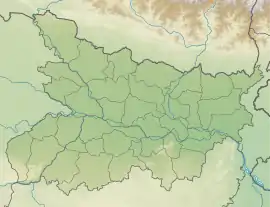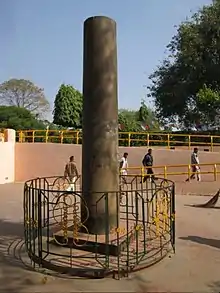Sujata Stupa
Sujata Stupa, also Sujata Kuti stupa or Sujata Garh, is a Buddhist stupa located in the village of Senanigrama (Bakraur) slightly east of Bodh Gaya in the state of Bihar, India. It lies directly across the Phalgu River from the town of Bodh Gaya, where Gautama Buddha is said to have attained enlightenment. It is a walk of about 20 minutes, from Bodh Gaya to Sujata Stupa. It was initially built in the 2nd century BCE as confirmed by finds of Dark Grey polished wares and a punch-marked coin in the monastery nearby.[1]
| Sujata Stupa | |
|---|---|
 General view of Sujata Stupa today. | |
| Religion | |
| Affiliation | Buddhism |
| Region | Bihar |
| Ecclesiastical or organizational status | Stupa ruins |
| Year consecrated | 2nd century BCE[1] |
| Location | |
| Location | India |
 Shown within India  Sujata Stupa (Bihar) | |
| Geographic coordinates | 24.6976432°N 85.0044857°E |
The stupa was dedicated to the milkmaid Sujata, from the village of Bakraur, who is said to have fed Gautama Buddha milk and rice at this spot as he was sitting under a Banyan tree, thereby ending his seven years of fasting and asceticism, and allowing him to attain illumination through the Middle Way.[2][3][4]

The stupa was originally adorned with a pillar of Ashoka, which was quarried in part for building material in the 1800s, then placed at the Gol Pather intersection of Gaya, and finally moved to Bodh Gaya in 1956.[5][6]
The stupa was an integral part of the original landscape at Bodh Gaya, and it was reinforced and enlarged several times over the centuries.[1]
The Archaeological Survey of India made excavations in 1973-74 and 2001-06.[7] A plaque found in the excavation has an inscription from the 8th-9th century CE that reads "Devapala Rajasya Sujata Griha", Devapala being interpreted as the 9th century Pala dynasty king, hence meaning "Sujata House, of King Devapala".[8][7] This suggests that the last phase of construction of the stupa dates to Devapala in the 9th century CE, to commemorate the house where Sujata lived.[8]
Before the discovery of this inscription, it was thought that this stupa had been dedicated to "Gandha-hasti", the "Perfumed elephant", and was therefore named "Gandha-hasti stupa". This interpretation was based on a description made by the 7th century Chinese pilgrim Hiuen Tsiang (in 大唐西域記: Buddhist Records of the Western World)[9] who recounted that when he crossed the river (Niranjana) and went to Bakraur, he encountered a stupa and a stone column at the place where Gandha-hasti used to dwell (referring to the place where the Buddha, in a previous life, was reborn as the offspring of a Perfumed elephant).[10][11]
References
- Geary, David; Sayers, Matthew R.; Amar, Abhishek Singh (2012). Cross-disciplinary Perspectives on a Contested Buddhist Site: Bodh Gaya Jataka. Routledge. pp. 35–36. ISBN 9781136320675.
- Prasoon, Shrikant (2007). Knowing Buddha : [life and teachings]. [Delhi]: Hindoology Books. ISBN 9788122309638.
- Planet, Lonely; Blasi, Abigail (2017). Lonely Planet India. Lonely Planet. ISBN 9781787011991.
- Dwivedi, Sunita; Lama, Dalai (foreword) (2006). Buddhist heritage sites of India. New Delhi: Rupa & Co. ISBN 8129107384.
- Geary, David (2017). The Rebirth of Bodh Gaya: Buddhism and the Making of a World Heritage Site. University of Washington Press. p. 209 Note 1. ISBN 9780295742380.
- O'malley, L. S. S. (2007). Bengal District Gazetteer : Gaya. Concept Publishing Company. pp. 200–201. ISBN 9788172681371.
- ASI notice
- Parishad, Bihar Purāvid (1977). The Journal of the Bihar Purävid Parishad. Bihar Puravid Parishad. p. 136.
- 大唐西域記: Buddhist Records of the Western World. Motilal Banarsidass. 1994. p. 138. ISBN 9788120811072.
- O'malley, L. S. S. (2007). Bengal District Gazetteer : Gaya. Concept Publishing Company. p. 21. ISBN 9788172681371.
- Pāṇḍeya, Jagadīśvara (1996). On the Footprints of the Buddha. p. 43.
| Wikimedia Commons has media related to Sujata Stupa. |
.jpg.webp)